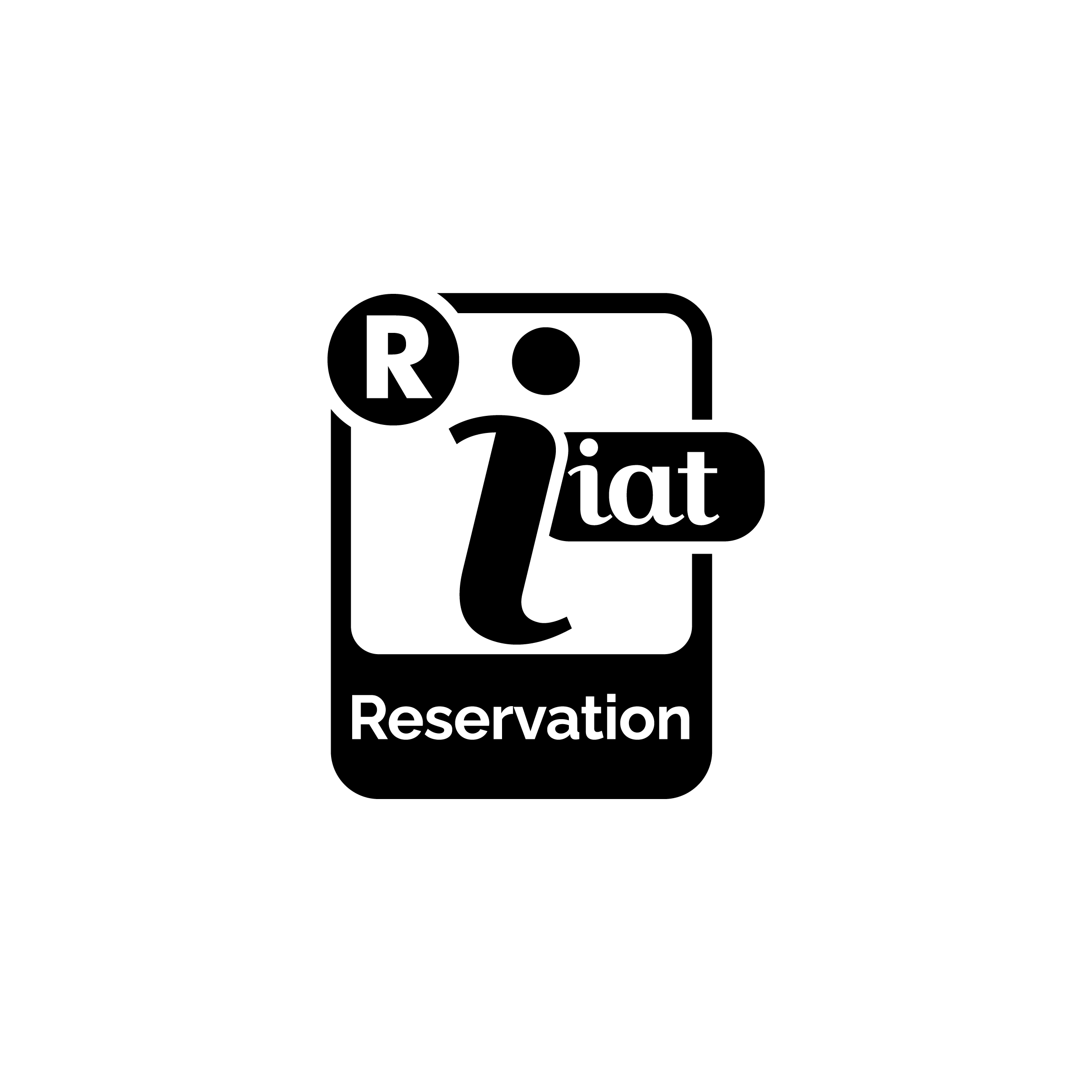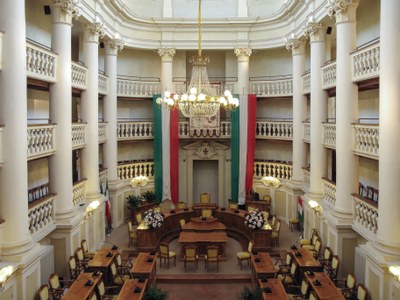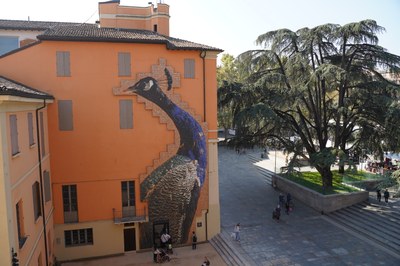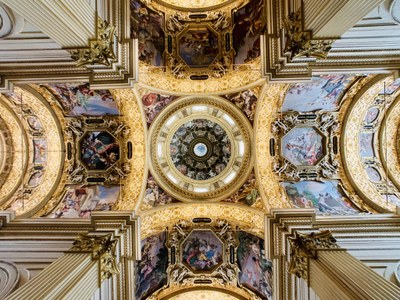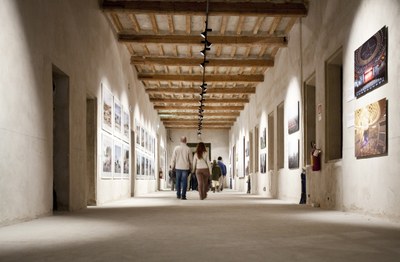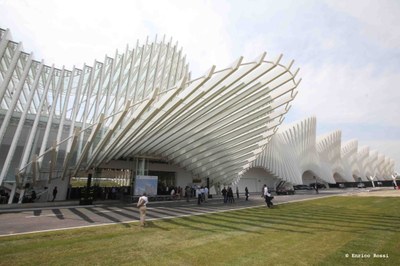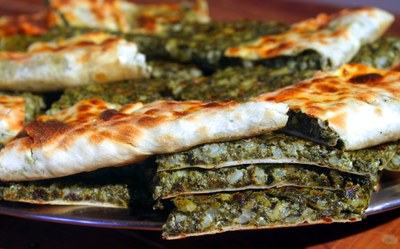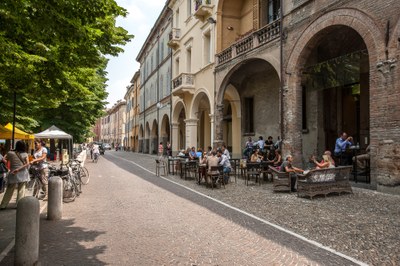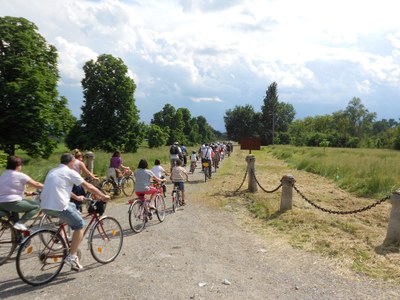10 reasons for a visit of Reggio Emilia
1. town of the tricolour flag
Every year, January 7, the Tricolour Flag Festival is officially celebrated, in the presence of the highest authorities. To learn the history of the Italian flag, we recommend a tour of the Tricolour Flag Hall and Museum (free entrance): the new exhibition tour starts with the redeveloped spaces on the ground floor, where the history of the flag opens up to a comparison with contemporary art and creativity.
2. MUSEums palace
Not only Tricolour Flag, but also archaeology, nature, ethnography, antiquities and contemporary works. This and much more is exhibited in the Museums Palace, recently redeveloped by architect Italo Rota.
It is a tour through the centuries, with the protagonists and excellences of our territory, from consul and founder Marco Emilio Lepido, to poet Ludovico Ariosto, from the Este possessions to the photographic work by Luigi Ghirri and the development of the European Photography Collection. The whole itinerary is characterized by spaces for discussion and contamination.
On the façade of via Secchi, a large Curiosa Meravigliosa (Curious Wonderful) photomosaic stands out, made up of over 12,000 shots collected by the artist Joan Fontcuberta as well as images from the museum collections: the photos, printed on ceramic tiles, compose an imposing peacock. A must for anyone visiting the town!
3. GHIARA church, REGGIO EMILIA's baroque treasure
Faith, art, history and ideals intertwine and merge in the churches, basilicas and monasteries of Reggio Emilia and its province: from the smallest and full of past to the most majestic. Each one has its own unique story and hidden secrets to reveal to all those who decide to spend a few hours of their stay in the town.
Among the many beautiful churches, the Basilica della Ghiara is a real treasure rich in art and history: it was built at the end of the XVI century, thanks to the offerings of the local faithful after a miracle. Inside it is possible to admire an extraordinary cycle of frescoes and altarpieces made by the best Emilian artists of the XVII century: Ludovico Carracci, Guercino, Lionello Spada, Alessandro Tiarini, Carlo Bononi and Luca Ferrari. The complex is completed by the Big Cloister, which now hosts a Youth Hostel, and the Small Cloister, which hosts the Ghiara Treasury Museum, open upon reservation.
4. CONTEMPORAry between art and photography
Reggio Emilia has a vocation for the contemporary: theatre, photography, architecture art and events. Spring, thanks to the many scheduled events, is the best time to discover its most intimate soul. The "European Photography" Festival is one of the most important and expected international events dedicated to contemporary photography, winner of the Photofestival of the Year at the Lucie Awards in 2022. Born in 2006, the festival takes place in several public and private locations, and is one of the best opportunities to discover ancient noble palaces, wonderful courtyards, cloisters, deconsecrated churches as well as several curious places .
However, Reggio Emilia is a real open-air museum: four contemporary artworks have been designed for specific places by the artists Luciano Fabro, Sol Lewitt, Eliseo Mattiacci and Robert Morris. Even the Cathedral itself has been enriched by remarkable contemporary artworks; just 2 km from the town centre you can visit one of the most important national contemporary art museums: the Maramotti Collection, designed as a factory for the production of Max Mara fashion garments; it has now become a permanent "museum" in constant evolution.
5. waves and arches by SANTIAGO CALATRAVA
The stay in Reggio Emilia of the Spanish architect definitively consecrated the town to the contemporary. His Bridges are now the new gates of the town: three big white arches, architectural works to be observed in motion even from the motorway, which with their sinuous and light shapes introduce the XXI-century Reggio Emilia.
Since June 2013, the Mediopadana high-speed train station has been added to the bridges. Entirely made of glass and white-painted steel, it weighs almost one and a half times the Eiffel Tower. The Station has been included among the most beautiful in the world by the Domus magazine; it is certainly worth a visit!
6. its majesty ERBAZZONE!
At breakfast, lunch or dinner, after a walk or sitting quietly chatting with friends, you cannot avoid tasting the real Reggio Emilia speciality: the erbazzone. A savoury salted pie based on spinach, chard, ricotta cheese, onions and the never failing Parmigiano Reggiano cheese.
It has numerous variations from the Po river to the Apennines, with both and without pasta and rice, but each version always retains its unmistakable uniquely typical taste.
7. squares
Traced and built 2,200 years ago by consul Marco Emilio Lepido, the Via Emilia gives its name to the region it crosses and to the town of Reggio Emilia. Near Via Roma is a commemorative plaque: this is where all began. If the Via Emilia is the mother of this town, the squares of its town centre are its integral part: in these places the town lives and welcomes. Walk, with no hurry, giving yourself time: the Palazzo del Monte tower marks the "slow hours" of the coffee bar tables, surrounded by the bright colorus of the buildings, by the composite architectural styles, by the constant presence of the bicycle as means of transport and "friendly" sociability during each season.
The wonderful Piazza Prampolini - the ancient Piazza Grande with the Cathedral, the Town Hall and the Tricolour Flag Hall. Then Piazza San Prospero with the church dedicated to the patron saint, the octagonal bell tower designed according to the advice of Giulio Romano and the spectacular six column-bearing lions in Verona marble standing guard over an XVIII-century exterior and an admirably frescoed XVI-century interior. Piazza Martiri del 7 luglio and Piazza della Vittoria with the magnificent XIX-century Teatro Municipale. Piazza Fontanesi, once occupied by a monastery then razed to the ground, is now surrounded by lime trees and recalls the famous Montmartre open space. It is the square of the old vegetable market and now hosts the zero kilometre farmer's market every Saturday and every evening, with its several coffee bars and delicatessen shops rich in typical specialities, welcomes fun, chats and dinners. Discover the town walking through the squares of Reggio Emilia!
8. from the first ITALIAN mural to the STREET ART Park
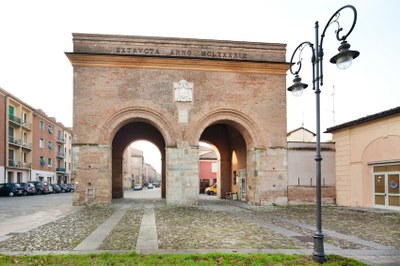 Via Roma is half aristocratic. The other half, the one that pushes towards the ancient Santa Croce gate, the main access from the north to the historic town (see the beautiful double arch of the customs post), is popular. In a small side street (Vicolo Venezia) you can still read a faded writing on the wall "The Righteous People wants snow". It has reportedly been created around the 40s of the XX century, and for this reason it might be the first Italian mural. A couple of meanings are attributed to the inscription: this area of the town is where the so-called Popol Giost (Righteous People) once lived, that is the poor part of the population who could get by with gimmicks and odd jobs, including snow shoveling: one of the two meanings of the inscription is really linked to the fact that the Righteous People expected the snow to be able to work a little more and, therefore, earn some money. The other meaning of the writing is instead more political: it is thought to be a sort of coded message where snow means the end of the fascist regime. After passing the ancient gateway to the town, walking along Viale Ramazzini, you reach the new technological core of the town: the Innovation Park, an area created as an industrial redevelopment of the former Officine Meccaniche Reggiane. The depots, the perimeter wall and the former dismantled factories are considered the biggest street art laboratory in Europe. You can discover the works and murals in the town by reading this article: Street art in Reggio Emilia.
Via Roma is half aristocratic. The other half, the one that pushes towards the ancient Santa Croce gate, the main access from the north to the historic town (see the beautiful double arch of the customs post), is popular. In a small side street (Vicolo Venezia) you can still read a faded writing on the wall "The Righteous People wants snow". It has reportedly been created around the 40s of the XX century, and for this reason it might be the first Italian mural. A couple of meanings are attributed to the inscription: this area of the town is where the so-called Popol Giost (Righteous People) once lived, that is the poor part of the population who could get by with gimmicks and odd jobs, including snow shoveling: one of the two meanings of the inscription is really linked to the fact that the Righteous People expected the snow to be able to work a little more and, therefore, earn some money. The other meaning of the writing is instead more political: it is thought to be a sort of coded message where snow means the end of the fascist regime. After passing the ancient gateway to the town, walking along Viale Ramazzini, you reach the new technological core of the town: the Innovation Park, an area created as an industrial redevelopment of the former Officine Meccaniche Reggiane. The depots, the perimeter wall and the former dismantled factories are considered the biggest street art laboratory in Europe. You can discover the works and murals in the town by reading this article: Street art in Reggio Emilia.
9. you can explore it on foot or by bicycle
Reggio Emilia is the town of the bicycle: the flat territory and the short distances make the tours easy and pleasant also for those traveling with the family. You can rent it at the Central Station and travel the over 250 km of cycle paths surrounding the town or the 25 km of greenways running alongside the river parks of Rodano, Crostolo and Modolena. In the town centre, three historic roads meet at the Museums Palace: Via Matildica del Volto Santo, Sentiero dei Ducati and Sentiero Spallanzani. In the province, wonderful oases, parks and nature reserves are the ideal destination for a relaxing holiday.
Do not miss the XIX-century public gardens and a detailed network of over 100 parks and green areas in the neighbourhood. A short distance from the town centre you enter the Crostolo Park, the most loved by the citizens: following the course of the torrent you first reach the Rivalta Park and Royal Palace, then the Vasca di Corbelli with Villa d'Este, both sumptuous buildings commissioned by the Dukes of Este during the XVIII century for their parties and fun.
10. everybody's town
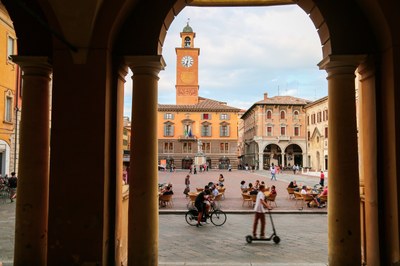
Reggio Emilia is the town of people, where everyone is welcome. A town attracting not only the classic tourist, focused on the main monuments, but the traveller who wishes to enjoy an all-round experience of the town and of its way of life. It is the typical Reggio Emilia approach: a kind, friendly town, open to the contemporary, which lets itself be explored and knows how to surprise.
It is the town of children, home to the Loris Malaguzzi International Centre, of many libraries with breastfeeding areas, of donkeys' houses and educational farms, which in its Apennines hosts the largest adventure park in Italy. It is the town without barriers, careful of people with disabilities: from the Polveriera, a former parade ground converted into a new space for social inclusion, to the new coffee bar run by deaf people, all examples of inclusion in Reggio Emilia! Just think of the hospitality of our four-legged friends: they may enter the three town museums for free, and a dog-sitter service is available upon reservation to visit the exhibitions at Palazzo Magani. It is the town of dance, home to the Fondazione Nazionale della Danza-Aterballetto (the main national company) and the new national choreographic centre.
Reggio Emilia is also the town of music and big artists: in the Teatro Municipale Valli debuted for the first time Luciano Pavarotti in Bohème, it is the birthplace of big names as Zucchero, Ligabue, Orietta Berti, Iva Zanicchi, Nomadi and hosts the biggest open-air concert arena in Europe, the RCF Arena.


